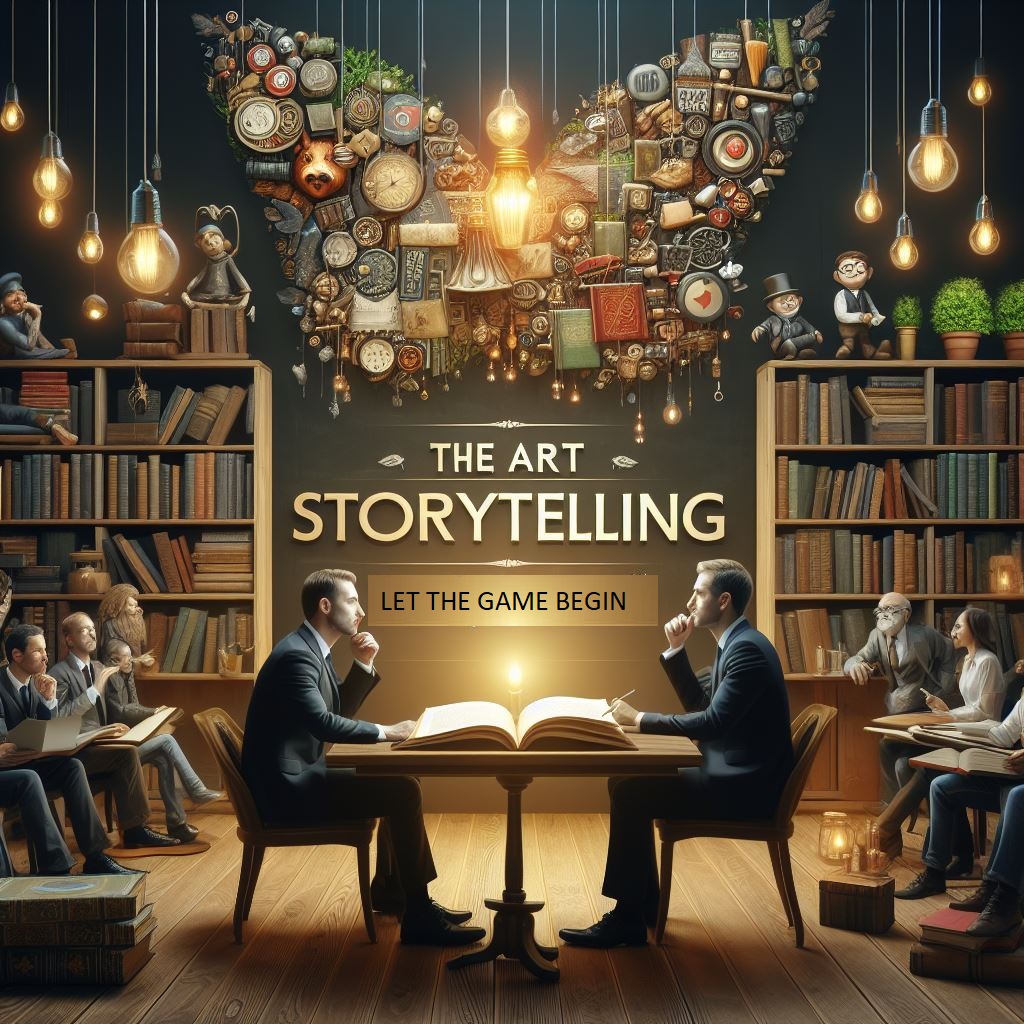The Art of Storytelling: The Secret of How The Top 1% of Brands Stand Out and Succeed
About Author

Raj Mavrik
Tech & Creativity Advocate
Sign Up for Our Free Weekly Newsletter
We’ll be in your inbox once a week with top business news, inspiring stories, best advice and exclusive reporting from Cinemagnetix – (CmX).

In today’s saturated markets, standing out as a brand is not just about having the best product or services like it used to be; it’s about telling a great story. The Top 1% of brands that gained success from this secret began practicing and eventually mastered the art of storytelling. These brands that capture hearts and minds are the brands that don’t just sell – they tell compelling stories. A strong narrative can transform a brand from a simple provider to an iconic status, enabling it to price differently and leverage extraordinary opportunities.
The Art of Storytelling: The Secret of How The Top 1% of Brands Stand Out and Succeed
The Power of a Good Story
Let’s take Cinemagnetix (CmX) as a prime example. At its core, CmX offers video production, lead generation and digital marketing solutions. However, the narrative CmX crafts is not primarily about these services. Some Stories are not planned but they unfold like in the case with CmX, they received feedback and thanks from the people they worked with. These stories were made clear by the community CmX had built over time. The key is to pay attention to your story and consciously let it shine. With CmX, the narrative Instead, is a story of connection – they are the bridge between businesses and their ideal clients. This narrative turns a service provider into a vital partner for growth. The underlying motor – video production – serves to propel their digital marketing strategies, thus weaving a compelling tale of how visual storytelling is integral to modern business success.
Storytelling Across Industries
This strategy is not unique to CmX, many successful big and small brands across various industries use storytelling to create a standout identity:
- Airbnb: Airbnb talks less about its properties and more about experiences and belonging. In comparison, the properties are similar to the features of an application service, but rather than focus on the amenities, they shifted the focus to the narrative which revolves around finding a ‘home away from home’, some may understand this narrative on a surface level, but when you go deeper, you’ll find that this narrative taps into the universal desire for adventure and local experiences, making their offering more than just a booking service.
- Apple: By now, the apple story is far and wide. Beyond technology, Apple’s narrative is about innovation, simplicity and enhancing lifestyle. The story isn’t about specifications and features alone; it’s about creating products that change the way we live and work, which justifies their premium pricing.
- BYD: BYD’s narrative is centered around its journey from a battery maker to a leading innovator in clean energy solutions. This narrative has successfully propelled BYD from a battery manufacturing company to a significant player in the electric vehicle market, positioning itself as a direct competitor to Tesla. BYD has successfully beat Tesla for two years straight in car production as they produced 3 million electric vehicles in 2023.
- Temu: Temu entered the highly competitive e-commerce space well dominated by giants like Amazon. However, Temu’s narrative focuses on democratizing shopping by making a wide range of high-quality products accessible at the lowest prices. When you observe the result of the narrative, you’ll discover that the story appeals to the savvy shopper who looks beyond the brand names, seeking value and variety.
- Nike: Nike sells athletic apparel, but their story is about more than just clothes and sneakers; it’s about aspiration, achievement, and inspiration. They’ve creatively been associated with athletes in various sports which aligns the stories of these athletes aspirations and achievements to Nike. “Just Do It” goes beyond a tagline— it’s a call to action for every athlete in the world, which creates an emotional connection with customers.
In today’s world, we have many storytellers and public speakers who speak about the art of storytelling, so if you’re looking solely at the surface level, you can search for some of those on YouTube. Over here, while everyone is looking at apples and oranges, we are always looking at seeds. So, I hope you would agree that this article would be incomplete without breaking the art of storytelling down into marketing strategies.
Integrating Storytelling into Marketing
The integration of storytelling into marketing strategies requires a few critical steps:
Identify the Core Message: What is the fundamental value or experience your brand offers? For CmX, about making meaningful business connections.
Emphasize Emotional Appeal: As long as you’re selling to humans and not extraterritoriales, understand the reality that people connect more deeply with emotions than with facts. Your story should evoke feelings that resonate with your audience, much like Nike inspires with tales of perseverance and triumph.
Consistency Across Channels: Imagine cooking two different soups at the same time in the same pot. That’s a recipe for total disaster or absolute genius. The takeaway is to ensure your story is consistent across all marketing channels. Whether it’s social media, your website, or advertisements, the narrative should be cohesive and clearly understood.
Engage Through Various Formats: Leverage different formats to tell your story. Take Steven Bartlett for example, his story is consistent across all social media platforms as the CEO who interviews amazing game changing people, even though he has other businesses, he manages the cohesiveness of the story very well across Videos, blogs, podcasts and social media thus, achieving a multidimensional storytelling strategy. This approach helps reinforce your message and increase its reach.
Apparently, the blog era is fading out and the streaming era is in full throttle. In other words, people don’t read any more and for this reason, the secrets are down here for the chosen ones.
So, If you’re still reading this, then you’re one of the curious ones with more questions. You may be asking, is there any framework to master the art of great storytelling? So, how about two?
Storytelling Frameworks: Structuring Brand Narratives for Impact
To truly master the art of storytelling, brands can benefit from adopting established storytelling frameworks that provide a structured approach to crafting compelling narratives. Two particularly effective models are the Hero’s Journey and the Pixar Story Spine. These frameworks not only help in constructing a story but also ensure that it resonates deeply with the audience, engaging them at an emotional level and driving home the brand’s message.
1. The Hero’s Journey:
Originally popularized by Joseph Campbell, the Hero’s Journey is a universal narrative framework that involves a hero who goes on an adventure, faces a crisis, wins a victory, and then comes home transformed.. Brands can use this model to position the customer as the hero and the brand itself as the mentor or guide that helps them overcome challenges. This framework is especially effective in creating a narrative where the product or service plays a crucial role in helping the hero achieve their goals.
The Application in Brand Storytelling:
- Introduction: Introduce the customer’s ordinary world and the problems they face.
- Adventure: Detail how the brand enters the story, offering a solution that helps the customer take on their challenges.
- Victory: Showcase the success stories or outcomes that customers achieve with the brand’s help.
- Transformation: Highlight how the customers are changed by the journey, ideally leading to a better understanding of their own needs and aspirations. In other words, they’ve gained wisdom and clarity.
2. The Pixar Story Spine:
This has been widely adopted overtime and most recently even used in short film projects, but the model was crafted by one of Pixar’s story artists; this formula is used to outline the basic structure of most Pixar films. It follows a simple template: Once upon a time there was blank . Everyday, blank. One day blank. Because of that, blank. Until finally blank. This model is highly adaptable and can be used to tell a brand’s story by focusing on simplicity and emotional appeal.
The Application in Brand Storytelling:
- Setup: “Once upon a time, there was a brand that noticed a widespread issue affecting its customers.”
- Routine: “Everyday, customers struggled with this issue, which made their lives more difficult.”
- Inciting Incident: ‘One day, the brand decided to address this issue by creating a revolutionary product.”
- Consequences: “Because of that, customers started to experience improvements, transforming their daily routines.”
- Climax: “Until finally, these customers could lead happier, more efficient lives thanks to the brand’s innovation.”
It’s all about your target audience. So, when incorporating these frameworks into your marketing strategy, consider the core values and emotional triggers of your target audience. Align your brand’s capabilities with the customer’s desires and challenges, ensuring that the story feels both authentic and relevant, Through blogs, video content, social media, or advertising, consistently apply the chosen framework to strengthen your narrative and enhance audience engagement.
To provide an extra layer of understanding, let’s take two scenarios and apply these lessons to them:
Scenario 1: The Dentist – “The Smile Architects”
Story Concept:
Imagine a dental clinic named “The Smile Architects,” where the focus is on crafting the perfect smile, which is treated as a personal masterpiece. The Narrative revolves around Dr. Faith, a doctor who believes that every smile she shapes helps sculpt her patients’ confidence and outlook on life.
Narrative Technique – Personalisation & Metaphor:
Dr. Faith views her dental practice as an art studio where smiles are her canvases. This metaphor transforms a regular dental visit into an artistic journey, making the service unique and intriguing.
Storytelling Implementation:
- Video Story: A beautifully shot video showcasing Dr. Faith at work, framed in slow-motion shots that capture her precision and attention to detail, much like an artist. The narration overlays, “At Smile Architects, we don’t just fix teeth; we craft confidence. Every smile is a story.”
- Patient Testimonials: Mini-documentaries that follow patients from their first consultation through their smile transformation, focusing on how their new smiles have transformed their lives.
- Social Media Content: Before-and-after photos paired with short stories about each patient’s journey and what their new smile has brought to their life.
Scenario 2: The Foundation – “Vision Beyond Sight”
Story Concept:
A foundation dedicated to helping the blind, named “Vision Beyond Sight,” focuses on enabling blind individuals to experience the world in new ways. The story centers on the foundation’s efforts to equip blind children with skills and technologies that open up new educational and personal opportunities.
Narrative Techniques – Sensory Storytelling & Symbolism:
The foundation’s story emphasizes the senses other than sight, like sound, touch, and emotion, to narrate experiences and successes. Symbolism is used to represent vision beyond the ability to see—showing vision as insight, perception, and understanding.
Storytelling Implementation:
- Campaign Video: A touching video that starts with the point of view of a blind child experiencing the world through other senses. The video transitions into how the foundation’s programs have impacted their daily life, like using technology to read or navigate cities.
- Impact Stories: Detailed blog posts or newsletter segments that narrate individual success stories, such as a blind student who, through the foundation’s programs, excels in school or creative field.
- Interactive Events: Virtual reality experiences set up at events that let donors and the public experience what it’s like to navigate the world without sight, enhancing empathy and understanding of the foundation’s mission.
These scenarios illustrate how storytelling can be tailored to different context, emphasizing the unique aspects of services and missions to engage the audience effectively. By weaving these narrative techniques into their marketing strategies, both the dentist and foundation can connect more deeply with their audiences, fostering engagement and encouraging support or patronage.
The Neuroscience Behind Storytelling is the reason why there’s a formula that has been working for the Top 1% Brands consistently.
Storytelling in marketing does more than just share information; it taps into the brain’s chemistry to build deep connections with the audience. When a brand tells a compelling story, it triggers the release of oxytocin, often called the ‘trust hormone,’ which makes us feel closer and more trusting of the brand. Good stories can also stimulate dopamine, the ‘feel-good hormone,’ making the experience enjoyable and memorable. This chemical cocktail not only enhances how we feel about a story but also cements the brand in our memories.
Using smart structured storytelling techniques, like developing relatable characters and enriching the narrative with vivid details, can boost these effects even further. When stories resonate on a personal level and engage our emotions, they forge powerful bonds.
Understanding the neuroscience behind this can help marketers craft campaigns that don’t just capture attention but also inspire true loyalty, turning casual listeners into lifelong fans.
Subscribe To Our Newsletter
Get updates and learn from the best
Artificial intelligence (AI) is no longer a futuristic concept; it’s revolutionizing how businesses operate today. From automating mundane tasks to personalizing customer experiences, AI offers a multitude of benefits for streamlining operations and boosting efficiency. This blog post will explore specific ways AI is impacting businesses in 2024, exploring its applications, benefits, and challenges with a focus on recent research findings and statistics.
In this blog post, we explored the balance between AI advancements and the authenticity of amateur content creation. While AI offers incredible tools for creators, it’s essential to maintain the human touch that makes content truly special. Let’s embrace AI as a challenge to innovate and enhance our creativity, ensuring that genuine voices continue to thrive in the digital landscape.
This blog post provides a comprehensive overview of the future impact of renewable energy on small businesses, offering valuable insights and practical information to help small business owners navigate this transformative trend.
Content creation is a cornerstone of digital marketing, playing a crucial role in attracting, engaging, and retaining customers. By understanding best practices and learning from successful case studies, marketers can significantly enhance their content strategies. This blog post will explore effective content creation strategies and highlight some inspiring success stories.
By leveraging these tools, you can streamline your marketing efforts, gain valuable insights, and ultimately drive better results for your business. Whether you’re focusing on SEO, content marketing, social media, or any other aspect of digital marketing, having the right tools at your disposal is crucial for success.
While lead generation is a crucial first step, relying solely on a platform like Smartleads.ai might leave your sales funnel feeling more like a graveyard than a thriving pipeline. In today’s competitive landscape, effective sales outreach requires a multi-faceted approach. In this post, we’ll unveil the limitations of Smartleads.ai (based on available information) and illuminate the path to success with a range of compelling alternatives. We’ll explore features, functionalities, user insights, and real-world success stories to help you find the perfect platform to resurrect your sales outreach efforts and unleash explosive growth. So, grab your metaphorical flashlight, and let’s explore the exciting world of alternative sales outreach solutions!
The art of the cold email remains a cornerstone of B2B outreach. In today’s digital age, however, simply crafting a compelling email and hitting send is no longer enough. With overflowing inboxes and increasingly sophisticated spam filters, the need for a strategic and automated approach has become paramount. This is where cold email software steps in.
This post dives deep into three leading contenders: Smartlead, Instantly, and Salesforge. We’ll explore their strengths, weaknesses, pricing, and ideal user profiles to help you choose the champion for your cold email crusade.
We’ll explore in depth the top marketing tool categories, exploring the strengths and weaknesses of industry leaders. This breakdown will empower you to make informed decisions and build a customized marketing arsenal that aligns with your specific goals and budget.












Absolute Master Piece Sir. This is saved to BookMarks.